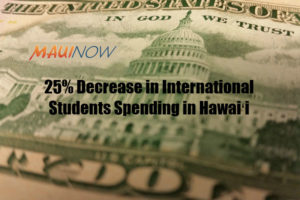25% Decline in International Students Spending in 2016-17
A report released today by the state Department of Business, Economic Development and Tourism found that foreign students in Hawaiʻi spent $225.3 million for the 2016-17 school year, a 25% decline from 2015-16.
The report, “The Economic Impact of International Students in Hawaiʻi – 2017 Update,” analyzed the impact of international students on Hawaiʻi’s economy and included the total living expenses and institutional tuition and fees in their estimate.
In 2015-16, direct spending by international students reached $302 million. The report states that the decrease reflects the broader nationwide recent trend of fewer foreign students applying to study in the US.
“The recent decline is part of a global trend for foreign students, but we will continue to take steps to attract and promote international student exchanges, as they have the potential for future business relationships, which benefit the economy,” said DBEDT Director Luis P. Salaveria.
Dennis Ling, administrator for BDSD, which leads the program for international student exchanges added, “We continue to work with our education partners to attract more foreign students to our classrooms. Although there was a year over year decline, foreign students studying in Hawaiʻi is very much a significant industry contributing much to our economy.”
Including the ripple effects, the total economic impact of international students are as follows:
• $484 million in total economic output, including direct and indirect effects.
• 5,093 jobs were supported by foreign student spending.
• $32.5 million in state taxes was generated from the foreign students.
The report showed Hawaiʻi hosted international students from all over the globe, and Japan remains the top country of origin for Hawaiʻi’s international students, followed by South Korea and China.
“We continue to promote cross-cultural understanding with international student exchanges to develop a global citizenry that we all desire,” said Gov. David Ige. “We understand the important role that education plays in cultivating the leaders of tomorrow into responsible global citizens.”
The report states other reasons for the decline range from more countries emphasizing in-country education, which is the case with Japan, as well as economic factors, and increased marketing by other destinations.
To counter the trend, DBEDT and the 29-member Study Hawaiʻi consortium of schools that banded together to market Hawaiʻi as a study destination will:
· Implement a Study Hawaiʻi Ambassador Program aimed at students who visit and study in Hawaiʻi to spread the word via social media as a place for education. The first Ambassadors of 80 students from Yasuda Women’s University of Hiroshima will be inducted on July 20, at graduation ceremonies conducted by the University of Hawaiʻi’s English Language Program.
· Host a press familiarization tour for education journalists from Asia and Europe. Journalists will be brought to Hawaiʻi to visit and meet with Hawaiʻi’s educational institutions to learn about Hawaiʻi as an education center.











